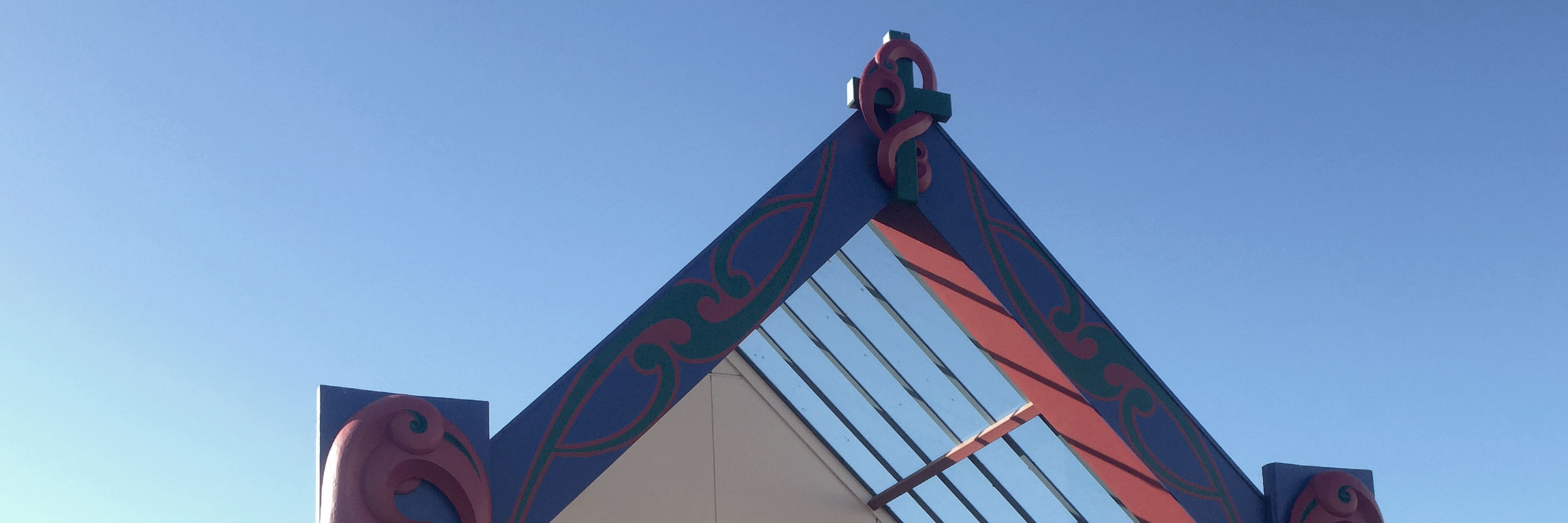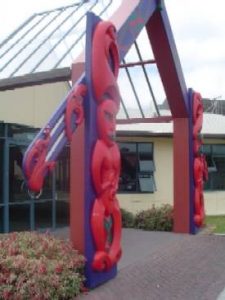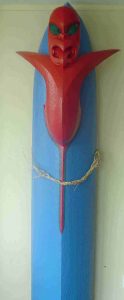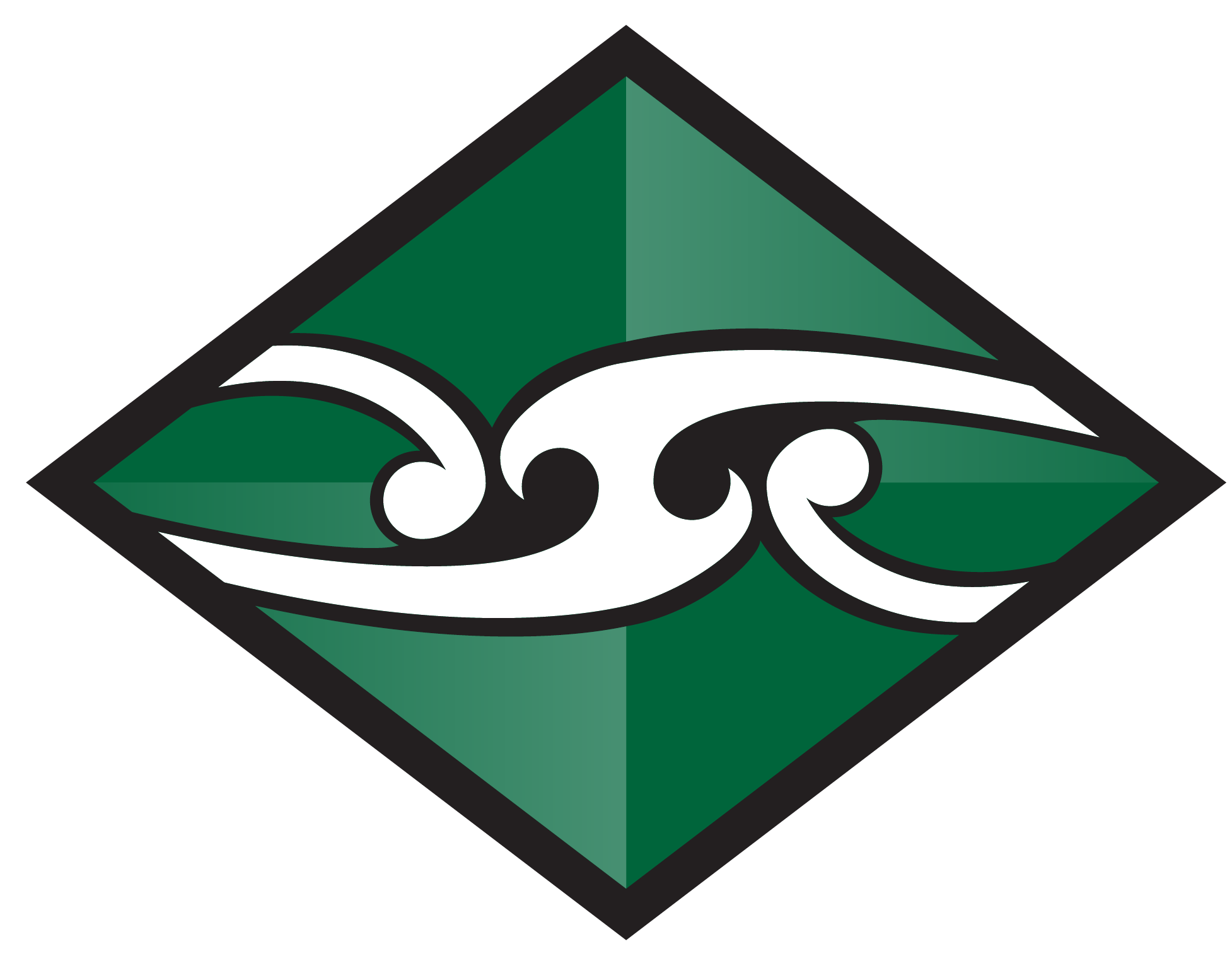The Diocesan Centre
As the central office of the Diocese, located next to the Diocesan Cathedral, The Diocesan Centre - Te Rau Aroha serves an important function as a place of work, gathering, training, are formation and celebration. The connection with the Mana Whenua (home people) of the region, Rangitāne, is made abundantly clear in the carvings that adorn the entrance.

Te Rau Aroha – The Leaf of Love
Outside Carvings
 Tane in Māori geneaology is the common male ancestor of all Māori people. He is the grandson of Io – Matua – Kore ( Io the parentless – God), Io begat Ranginui, the skyfather and Papatūānuku, the earthmother. They had many children, one of importance being Tane. He stands at the right hand side of Te Rau Aroha.
Tane in Māori geneaology is the common male ancestor of all Māori people. He is the grandson of Io – Matua – Kore ( Io the parentless – God), Io begat Ranginui, the skyfather and Papatūānuku, the earthmother. They had many children, one of importance being Tane. He stands at the right hand side of Te Rau Aroha.
Hineahuone in Māori geneaology is the common female ancestor of all Māori people. She is the great grand-daughter son of Io – Matua – Kore ( Io the parentless – God), Io begat Ranginui, the skyfather and Papatūānuku, the earthmother. Tane fashioned Hineahuone out of sand and blew the breath of life into her, that is, tihei mauri ora – the breath of life. Hineahuone stands at the left hand side of Te Rau Aroha.
The people Embracing Christianity is represented on the apex of the carvings. This is represented by a figure representing the people, Māori and settlers, who have come to embrace Christianity.
People on a journey is represented on the right hand side gable leading up to the apex. The journey for Māori is one of faith and is painted in traditional and contemporary colours. This indicates the journey is not just one of the past, but one of the present and future.
Settlers on a Journey is represented on the left hand side gable leading up to the apex. The settlers journey is one of faith and is painted in traditional and contemporary colours. This also indicates the journey is not just one of the past, but one of the present and future.
A new age is expressed by the use of the traditional (red, white and black) and more specifically the new colours. This symbolises the ever evolving nature of the church, the faith and our diocese.
Tanenui-a-rangi – The Inside Carving
 Tanenui-a-rangi is one of the common ancestors of the Māori people. More importantly the Rangitāne people, who are tangata whenua of the Palmerston North area, descend directly from this ancestor. As the Bishop of Palmerston North invites us all into the entrance and gathering place, the Rangitāne people, through Tanenui-a-Rangi, also support the call of ‘Welcome’.
Tanenui-a-rangi is one of the common ancestors of the Māori people. More importantly the Rangitāne people, who are tangata whenua of the Palmerston North area, descend directly from this ancestor. As the Bishop of Palmerston North invites us all into the entrance and gathering place, the Rangitāne people, through Tanenui-a-Rangi, also support the call of ‘Welcome’.
Whakapapa Bloodlines and the sense of belonging is important in may cultures. The red line than runs from Tanenui-a-Rangi to the ground reminds us of the past, present and future generations of Rangitāne. The bloodline also reminds us that they hold the Mana Whenua –Sphere of Influence over the Land as the Tangata Whenua.
Tauihu, or the canoe prow was used by many Māori as Pou Whenua – Territory Markers. These canoe prows and similar carvings may be seen at certain points of the Rangitāne boundaries around Palmerston North.
Te Wharenui – The Large House
 Carvings, the language of artists. Māori have retained a very strong oral tradition. Connected to this was a well developed skill to hold vast segments of information in the mind which also fed the traditions of story telling, recitation of genealogy and historical events. Whilst there was no written language, carvings became the visual language of the day.
Carvings, the language of artists. Māori have retained a very strong oral tradition. Connected to this was a well developed skill to hold vast segments of information in the mind which also fed the traditions of story telling, recitation of genealogy and historical events. Whilst there was no written language, carvings became the visual language of the day.
Wharenui are quite common around the island. So what does the wharenui symbol? The wharenui is seen as the body of the ancestor or purpose of its name. When approaching the front of the meeting house you will see the arms (maihi), the fingers (raparapa), the legs (amo), the name/ purpose of the house (karuru), the eye/s (matapihi), and the mouth (kawaha) of the house.
Te Rau Aroha
Our wharenui is called Te Rau Aroha, the Leaf of Love. There is a beautiful parallel here between the Māori culture and the Old Testment.
The rau aroha is the leaf of peace laid down before visitors (manuhiri) by the warrior who performs the challenge (wero) with a long club (taiaha) on the marae.
In the old testament the olive leaf was carried by the white dove on Noahs Ark to announce that land had been found, a new beginning, a new start, a new world.
Latest News and Resources
Review of End of Life Choice Act: submissions now open
General
Published on 31st Aug, 2024
The first review, overseen by the Ministry of Health, is currently taking place [..]
Sisters conserve rare flag
General
Published on 31st Aug, 2024
A rare military flag has received much needed conservation work from the Carmelite Sisters [..]
Letter from Archbishop Paul Martin
General
Published on 5th Jun, 2024
A Vatican-led review of an abuse complaint against Cardinal John Dew dating to the 1970s has conclud [..]
'No Faith in Fossil Fuels' Climate Action Week
General
Published on 22nd Apr, 2024
We invite you to participate in No Faith in Fossil Fuels Climate Action Week from 3 May to 12 May [..]
